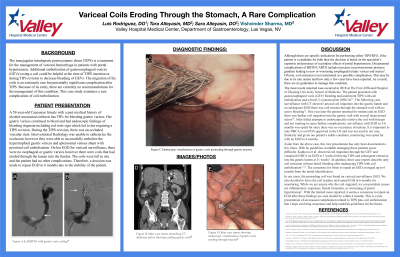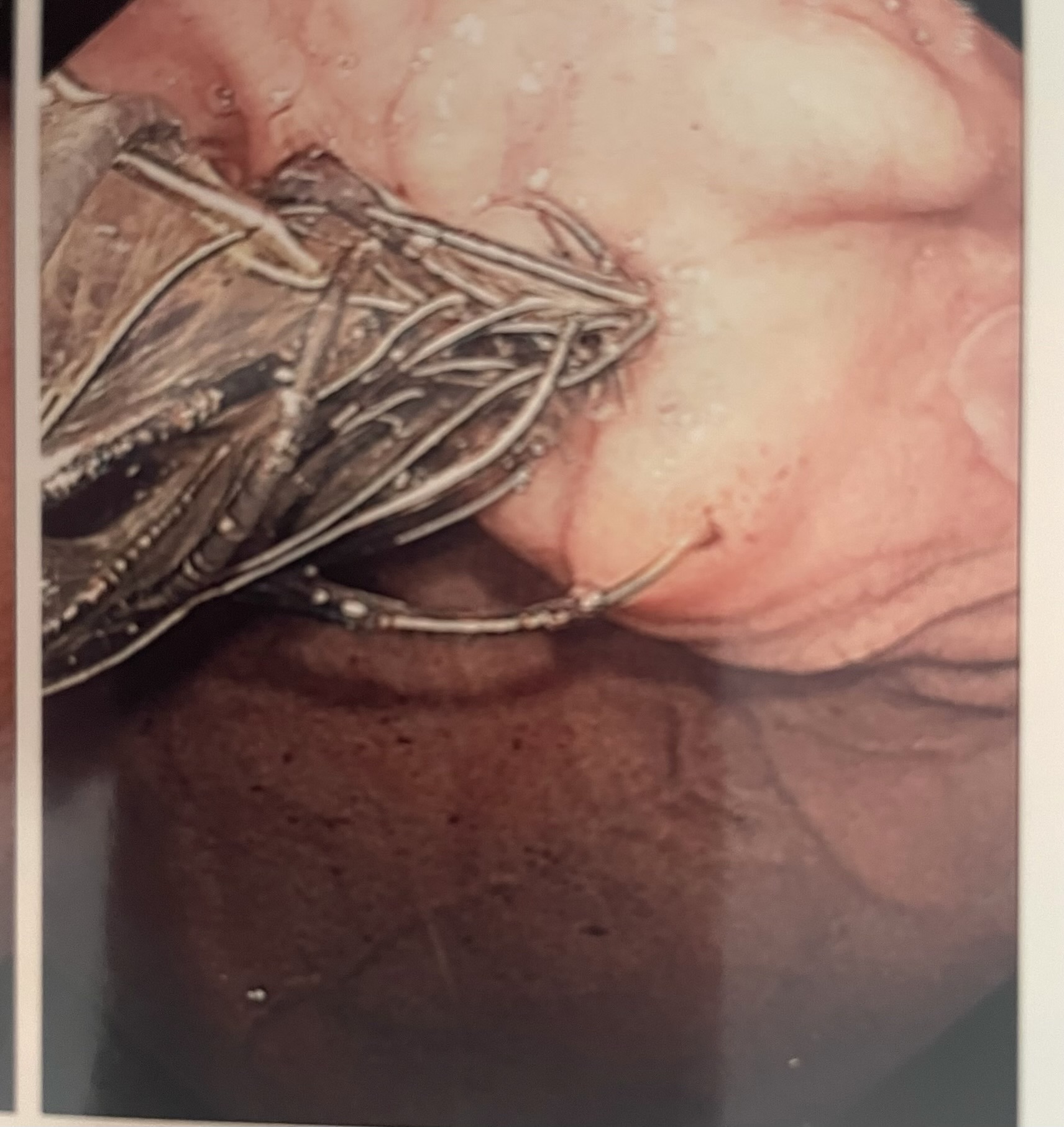Monday Poster Session
Category: Liver
P3065 - Variceal Coils Eroding Into Stomach
Monday, October 28, 2024
10:30 AM - 4:00 PM ET
Location: Exhibit Hall E

Has Audio

Luis Rodriguez, DO
Valley Hospital Medical Center
Las Vegas, NV
Presenting Author(s)
Luis Rodriguez, DO1, Tara Alleyasin, MD2, Sara Alleyasin, DO1, Vishvinder Sharma, MD1
1Valley Hospital Medical Center, Las Vegas, NV; 2Scripps Green Hospital, La Jolla, CA
Introduction: The transjugular intrahepatic portosystemic shunt (TIPS) is a treatment for the management of variceal hemorrhage in patients with portal hypertension. Additional embolization of gastroesophageal varices (GEVs) using a coil could be helpful at the time of TIPS insertion or during TIPs revision to decrease bleeding of GEVs. The migration of the coils is an extremely rare but potentially significant complication after TIPS. Because of its rarity, there are currently no recommendations for the management of this condition. This case study examines a rare complication of coil embolization.
Case Description/Methods: A 59-year-old Caucasian female with a past medical history of alcohol-associated cirrhosis has TIPs for bleeding gastric varices. Her gastric varices continued to bleed and had endoscopic findings of bleeding stigmata including red wale sign which led to her requiring a TIPS revision. During the TIPS revision, there was an occluded vascular stent. Interventional Radiology was unable to catheterize the occlusion; however they were able to successfully embolize the hypertrophied gastric varices and splenorenal venous shunt with proximal coil embolization. On her EGD for variceal surveillance, there were no esophageal or gastric varices however there were coils that had eroded through the lumen into the fundus. The coils were left in situ and the patient had no other complications. Therefore, a decision was made to repeat EGD in 6 months due to the stability of the patient.
Discussion: The present case reports a rare but significant complication after TIPS. Presently, the outcome of this complication is unknown. However, it may potentially contribute to rebleeding or gastric perforation. The erosion of a coil into the gastric fundus seen on EGD is a unique finding. There are only a few reported cases documented in the literature describing coil expulsion through gastric varix in patients having previously undergone TIPS with coil embolization. The mechanisms of gastric varix coil migration and erosion into the stomach are unknown. It could possibly be due to surrounding inflammation leading to fistula formation or expansion of the variceal lumen in the setting of recurrent portal hypertension. There is little information available pertaining to both the cause and the treatment of this complication. Prior cases did choose repeating an EGD at a later date. The purpose of this case report is to encourage continued research and reporting of such cases along with the effectiveness of treatment.

Disclosures:
Luis Rodriguez, DO1, Tara Alleyasin, MD2, Sara Alleyasin, DO1, Vishvinder Sharma, MD1. P3065 - Variceal Coils Eroding Into Stomach, ACG 2024 Annual Scientific Meeting Abstracts. Philadelphia, PA: American College of Gastroenterology.
1Valley Hospital Medical Center, Las Vegas, NV; 2Scripps Green Hospital, La Jolla, CA
Introduction: The transjugular intrahepatic portosystemic shunt (TIPS) is a treatment for the management of variceal hemorrhage in patients with portal hypertension. Additional embolization of gastroesophageal varices (GEVs) using a coil could be helpful at the time of TIPS insertion or during TIPs revision to decrease bleeding of GEVs. The migration of the coils is an extremely rare but potentially significant complication after TIPS. Because of its rarity, there are currently no recommendations for the management of this condition. This case study examines a rare complication of coil embolization.
Case Description/Methods: A 59-year-old Caucasian female with a past medical history of alcohol-associated cirrhosis has TIPs for bleeding gastric varices. Her gastric varices continued to bleed and had endoscopic findings of bleeding stigmata including red wale sign which led to her requiring a TIPS revision. During the TIPS revision, there was an occluded vascular stent. Interventional Radiology was unable to catheterize the occlusion; however they were able to successfully embolize the hypertrophied gastric varices and splenorenal venous shunt with proximal coil embolization. On her EGD for variceal surveillance, there were no esophageal or gastric varices however there were coils that had eroded through the lumen into the fundus. The coils were left in situ and the patient had no other complications. Therefore, a decision was made to repeat EGD in 6 months due to the stability of the patient.
Discussion: The present case reports a rare but significant complication after TIPS. Presently, the outcome of this complication is unknown. However, it may potentially contribute to rebleeding or gastric perforation. The erosion of a coil into the gastric fundus seen on EGD is a unique finding. There are only a few reported cases documented in the literature describing coil expulsion through gastric varix in patients having previously undergone TIPS with coil embolization. The mechanisms of gastric varix coil migration and erosion into the stomach are unknown. It could possibly be due to surrounding inflammation leading to fistula formation or expansion of the variceal lumen in the setting of recurrent portal hypertension. There is little information available pertaining to both the cause and the treatment of this complication. Prior cases did choose repeating an EGD at a later date. The purpose of this case report is to encourage continued research and reporting of such cases along with the effectiveness of treatment.

Figure: Gastric variceal coil seen in the fundus
Disclosures:
Luis Rodriguez indicated no relevant financial relationships.
Tara Alleyasin indicated no relevant financial relationships.
Sara Alleyasin indicated no relevant financial relationships.
Vishvinder Sharma indicated no relevant financial relationships.
Luis Rodriguez, DO1, Tara Alleyasin, MD2, Sara Alleyasin, DO1, Vishvinder Sharma, MD1. P3065 - Variceal Coils Eroding Into Stomach, ACG 2024 Annual Scientific Meeting Abstracts. Philadelphia, PA: American College of Gastroenterology.
